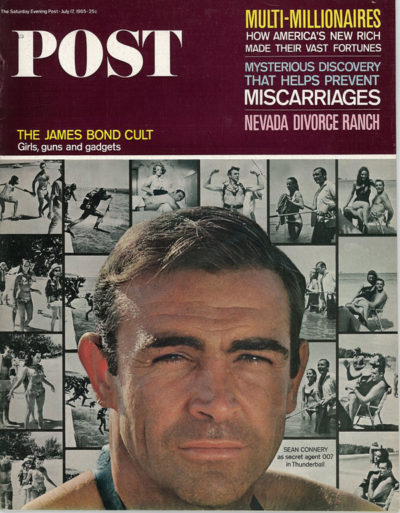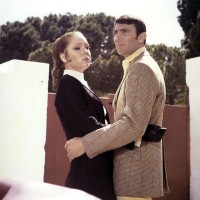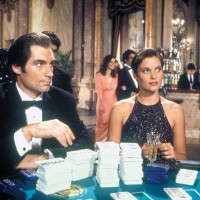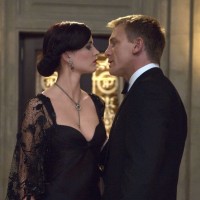James Bond Turns 50
Bond. James Bond.
The first time a 32-year-old Scottish actor uttered those words was in a small film that opened in London 50 years ago. Based on a popular pulp novel by Ian Fleming, Dr. No cost slightly over $1 million and featured a group of not-yet stars including Sean Connery, Jack Lord (“Hawaii Five-O”), and Ursula Andress alongside an established character actor, Joseph Wiseman, as the movie’s villain.
It was a film that debuted with no expectations whatsoever. Months later, when Dr. No opened in the U.S., The New York Times called it “lively” and “amusing,” a “spoof of science fiction and sex.” Translation: a cute, entertaining trifle.
Yet, lo and behold, Dr. No grossed nearly $60 million worldwide—fantastic box office for that time—and spawned a film franchise that has produced 22 feature films (the 23rd, Skyfall, is due out in October) with global earnings of more than $5 billion.
In an era when big budget extravaganzas such as Lawrence of Arabia and The Longest Day attracted the largest audiences, Dr. No’s success seemed to come out of nowhere. Yet the reasons why it succeeded were easily discernable. “The formula was simple,” says film critic and author Irv Slifkin of moviefanfare.com. “A good-looking guy who was lethal yet likable, gorgeous women, nasty villains, nifty gadgets, nice locations, and cool music—all presented in first class fashion with a dollop of violence and sex and, in some cases, politics.”
“Bond tapped into a full range of male fantasies and desires that were simultaneously being exploited by popular media and international advertising at the height of post-war consumerism,” adds Christoph Lindner, editor of The James Bond Phenomenon: A Critical Reader. “There is a great study of the interrelations—both commercial and artistic—between Bond and Playboy magazine in the early 1960s, showing that both developments shared many values and perspectives, not just on sex and women, but also on conspicuous consumption and the fetishism of technology.”
In other words, gorgeous women and cool gadgets—not to mention Cold War paranoia and wackadoodle plot lines far removed from the dour and more realistic spy flicks of the era—were some of the keys to the films’ success. And if you were female, well, you might not have liked the casual sexism of the Bond series, but there was always Sean Connery, about as studly as they come, to satisfy your fantasies. As Slifkin puts it: “The women came for James, and the men came for everything else.” [Not everyone was buying 007. For a contemporary, critical view of Bond and his movies, read William K. Zinsser’s 1965 article “The Big Bond Bonanza” —ed.]

And they kept coming back for more. When Sean Connery bowed out of the series, they came for George Lazenby, and then Roger Moore, Timothy Dalton, Pierce Brosnan, and now Daniel Craig. The villains changed, the women came and went, the plots sometimes became utterly ridiculous—like in 1979’s Moonraker, which involved a master race, a plot to exterminate all human life, and a battle on a space station—but none of that seemed to matter. Bond was part of the culture. Which meant it became hard to find people who didn’t know who Q, M, and Miss Moneypenny were; who weren’t familiar with Odd Job and Jaws; and who didn’t know that Bond liked his martinis “shaken, not stirred.”
In fact, this familiarity worked in the series’ favor. One of the reasons 007 managed to survive from the Cold War era into the post-9/11 world is that the more things changed, the more Bond tended to stay the same. According to Glenn Yeffeth, editor of James Bond in the 21st Century, Bond is “good at what he does, and he is an openly heterosexual male, unashamed of his own manhood. Those characteristics seem to be as relevant as they ever were. If you look at Jack Bauer in the TV show “24,” I think what people like about that character are the same characteristics.”
There’s also Bond’s relationship with his bosses, which remains highly volatile. 007 is an insider who acts like an outsider, and that tension has been constant throughout the series. “At one level he represents a fantasy of government control in a geopolitical world that has lost its grip on western security,” says Lindner, “but at another level he also represents a fantasy of escape from the excessive authority and surveillance of government. This tension between control and escape is an important part of Bond’s success over the decades.”
And then there’s the most obvious way in which the series stays current—when it comes to enemies, Bond is always after the villain du jour. “The films have always reflected the times in which they were made,” says Yefeth. “In the ’60s, it was Cold War espionage and the beginnings of the sexual revolution. In the ’70s and ’80s, they became more comedic and fantastical in the era of overindulgence. But the fundamental principles of Bond haven’t changed. He is intent on trying to preserve world order. For each era, Bond has found his way.”
Which means that in the latest reboot of the series, Daniel Craig’s 007 has been fighting a gaggle of very contemporary bad seeds who finance international terrorism (Casino Royale) or are out to control an entire nation’s water supply (Quantum of Solace).
And there is one more significant way in which Bond has kept up with the times. Even though he’s as tough as ever, he has become more emotionally open. “Fleming’s original Bond from the novels was a deeply flawed and emotionally damaged character,” says Lindner. “Over the years, the films gradually turned Bond into a teflon spy. But now, in the post-9/11 era—and thanks in part to other spy franchises like the Jason Bourne trilogy—Bond has rediscovered his emotions and his imperfections.”
So what’s not to like? He’s macho. He’s emotional. He’s even become, if the most recent films are any indication, almost—but not quite—monogamous. And in a world that seems even more chaotic and dangerous than the one in which he first appeared, we all know that when evil rears its ugly head, there’s one secret agent we can always count on.
Bond. James Bond.
Best of Bond
There have been 22 Bond films so far. In chronological order, here are my picks for the five best. —L.B.
From Russia With Love (1963)

Why It’s Great: A Cold War spy caper with superbad villains intent on world domination. Bonus: A top-notch supporting cast including Robert Shaw and Lotte Lenya.
Main Villain: Ernst Stavro Blofeld, the consummately evil head of SPECTRE shown only from the neck down as he strokes his white cat. Equally freaky and fearsome—Rosa Klebb (Lenya), the killer with poison-tipped blades concealed in the toes of her shoes.
Bond Babe: Tatiana Romanova (Daniela Bianchi), Russian agent turned Bond ally.
Cool Gadget: A special briefcase including a rifle and ammunition plus 50 gold sovereigns, a knife, and a tear gas cartridge disguised as talcum powder.
Memorable Dialogue: Tatiana, trying on dresses – “I will wear this one in Picadilly.” Bond – “You won’t. They’ve just passed some new laws there. ”
Goldfinger (1964)

Why It’s Great: A daring robbery plan, nasty supervillain, and that smiling henchman Oddjob (Harold Sakata). Mix that with a female flying corps, one of the best Bond title songs (sung by Shirley Bassey), and a terrific final action sequence and you get perhaps the greatest Bond ever.
Main Villain: Auric Goldfinger (Gert Fröbe), master criminal who wants to rob Fort Knox.
Bond Babe: Pussy Galore (Honor Blackman), Bond enemy turned ally.
Cool Gadget: Awesome Aston Martin with passenger ejection seat, forward machine guns, hubcaps doubling as tire slashers, and other goodies.
Memorable Dialogue: Stewardess – “Can I do anything for you?” Bond – “Just a drink. A martini, shaken, not stirred.”
On Her Majesty’s Secret Service (1969)

Why It’s Great: George Lazenby is no Sean Connery, but he’s okay as Bond, and the film is tight, smart, and extremely well directed with killer action sequences. Bonus: We find 007 in love.
Main Villain: Ernst Stavro Blofeld (Telly Savalas), doing some strange allergy research involving beautiful women.
Bond Babe: Teresa di Vicenzo (Diana Rigg), who marries Bond, but is murdered on their wedding day.
Cool Gadget: Radioactive lint, which acts as a homing device.
Memorable Dialogue: Draco (Gabriele Ferzetti) – “My apologies for the way you were brought here. I wasn’t sure you’d accept a ‘formal’ invitation.” Bond – “There’s always something formal about the point of a pistol.”
Licence To Kill (1989)

Why It’s Great: Criminally underrated at the time, this is an exciting action film with Timothy Dalton as a nasty, driven Bond out to stop a drug lord and avenge a near-fatal attack on his friend Felix Leiter (David Hedison).
Main Villain: Franz Sanchez (Robert Davi), South American drug kingpin based on Pablo Escobar.
Bond Babe: Pam Bouvier (Carey Lowell), CIA informant posing as a drug courier who falls for Bond.
Cool Gadget: A camera that can be converted into a rifle and programmed so only one person can fire it.
Memorable Dialogue: Bond, when asked to cut a wedding cake – “I’ll do anything for a woman with a knife.”
Casino Royale (2006)
Why It’s Great:Grade A reboot of the series featuring a macho but sensitive Daniel Craig as 007 and smashing action sequences.

Main Villain: Le Chiffre (Mads Mikkelsen), a banker for terrorist organizations.
Bond Babe: Vesper Lynd (Eva Green), double agent supposedly monitoring Bond’s expenses but also working for a terrorist organization. She soon falls for our hero.
Cool Gadgets: Film is low on futuristic gadgetry because it is about the start of Bond’s career as a “00.” Still, his Aston Martin has a glove compartment with antidotes to various poisons and a portable defibrillator. Most laughable is his Sony Ericsson cellphone with (get this!) GPS and a 3.2 megapixel digital camera!
Memorable Dialogue: Lynd – “It doesn’t bother you? Killing all those people?” Bond – “Well, I wouldn’t be very good at my job if it did.”